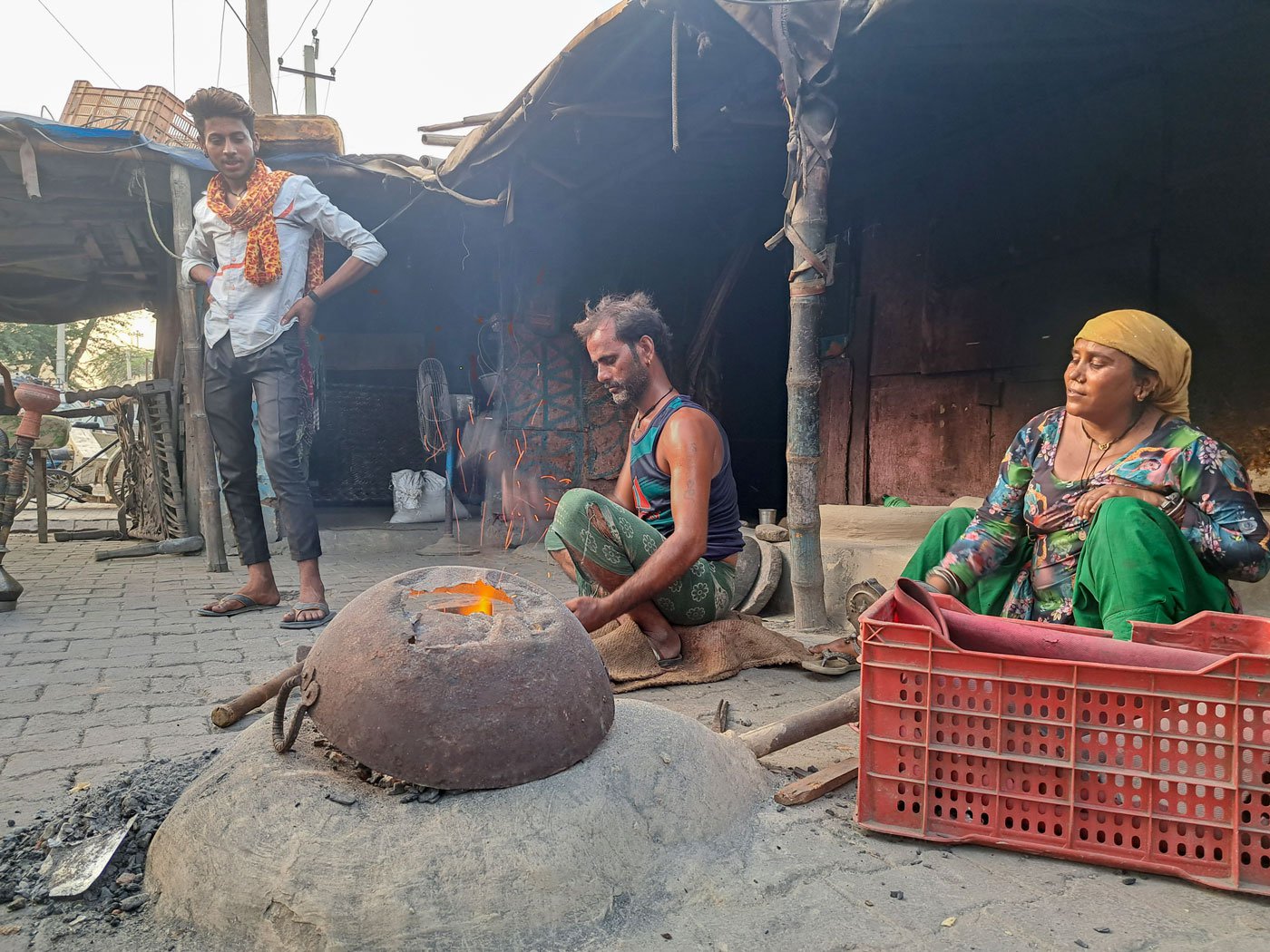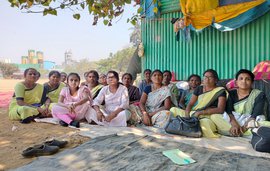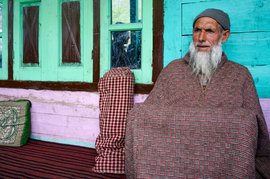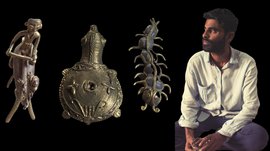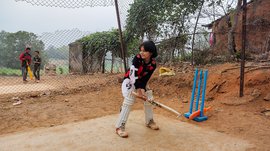“Every time the bhatti [furnace] is lit, I injure myself.”
Salma Lohar’s knuckles are scarred and two on her left hand are split open. She picks a handful of ash from the furnace and rubs it in to speed up the healing.
The 41-year-old’s family is one of six Lohar families who call a chain of juggis in Sonipat’s Bahalgarh market their home. On one side is the busy market road and on the other is a municipal garbage dump. There is a government toilet and water tanker nearby and Salma and her family rely wholly on these facilities.
The juggis have no electricity and if it rains for more than 4-6 hours, the entire settlement floods – as it did last October (2023). At such times they have to sit on their cots with their legs drawn up, waiting for the water to recede – it takes 2-3 days. “It stinks a lot during those days,” Dilshad, Salma’s son, recalls.
“But where else will we go?” Salma asks. “I know that living here next to trash makes us ill. Flies that sit there come and sit on our food too. But where else will we go?”
The Gadia, Gadiya or Gaduliya Lohars are listed as a Nomadic Tribe (NT) as well as a Backward Class in Rajasthan. People belonging to this community also live in Delhi and Haryana but while they’re recognised as a Nomadic Tribe in the former, they are termed a Backward Class in Haryana .
The market where they live is next to state
highway 11 and attracts vendors selling fresh produce, sweets, kitchen
condiments, electrical devices and much more. Many set up stalls and leave once
the market closes.


Left: The Lohars call this juggi in Bahalgarh market, Sonipat, their home. Right: Salma Lohar with her nine-year-old niece, Chidiya


They sell ironware like kitchen utensils and
agricultural implements including sieves, hammers, hoes, axe heads, chisels,
kadhais
, cleavers and much more. Their home (and workplace) is right by the
road in the market
But for people like Salma, the market is both home and workplace.
“My day starts early, around 6 a.m. When the sun rises, I have to light the furnace, cook for my family, and then get to work,” says the 41-year-old. Together with her husband Vijay, she works at the furnace twice a day for long stretches, melting and hammering iron scraps into utensils. In a day they manage to make four or five of them.
Salma’s chance for a break from work comes in the afternoon, with a hot cup of tea which she drinks sitting on her cot, flanked by two of her children: her only daughter Tanu is 16 and her youngest son Dilshad is 14. Her sister-in-law’s daughters – Shivani, Kajal and Chidiya – are also around. Only nine-year-old Chidiya goes to school.
“Will you put this on WhatsApp?” asks Salma. “Mention my work first!”
The tools of her trade and the finished products gleam in the afternoon sun – sieves, hammers, hoes, axe heads, chisels, kadhais , cleavers and much more.
“Our tools are the most precious things in this
juggi
,” she says, squatting before a
large metal pan. Her break over, the tea cup in her hand is replaced by a
hammer and chisel. With an ease that comes from practice, she hammers holes
into the bottom of the pan, changing the angle of the chisel after every two
strikes. “This sieve is not for the kitchen. Farmers use it to sort grain.”
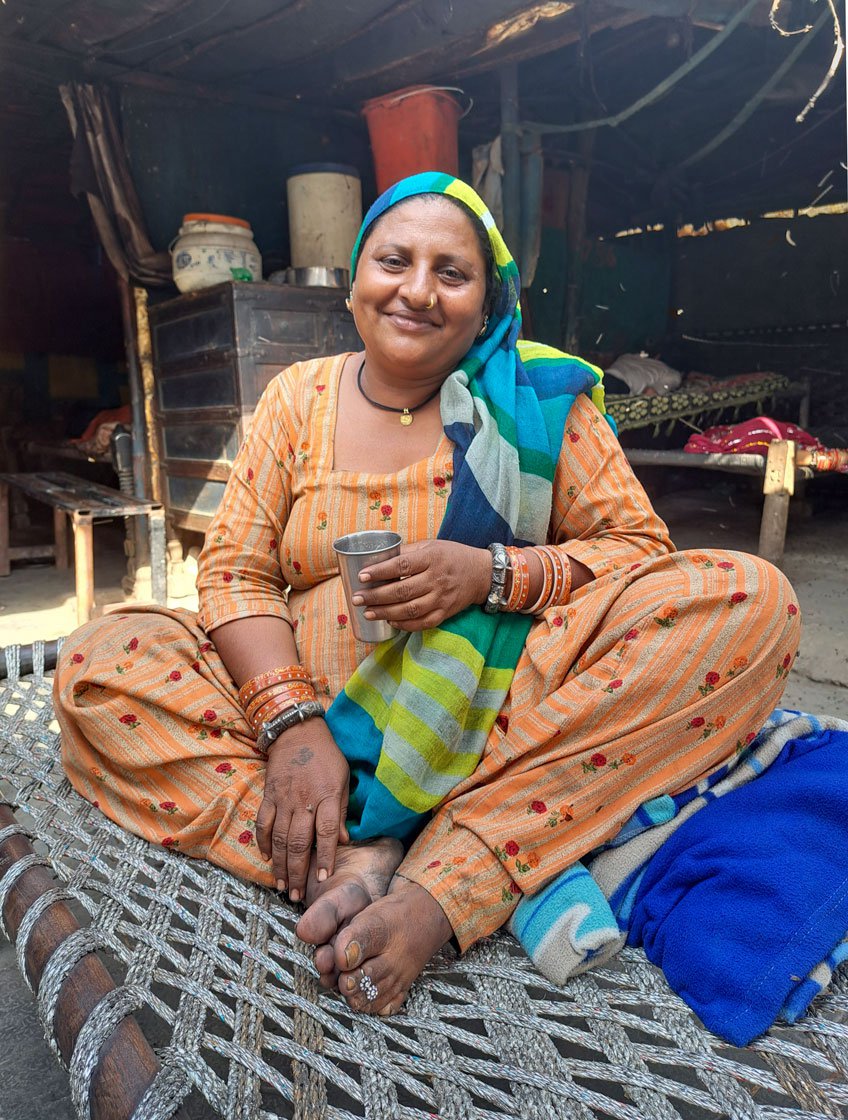

Left: Salma’s day begins around sunrise when she cooks for her family and lights the furnace for work. She enjoys a break in the afternoon with a cup of tea. Right: Wearing a traditional kadhai ( thick bangle), Salma's son Dilshad shows the hammers and hoes made by the family


Salma uses a hammer and chisel to make a sieve which will be used by farmers to sort grain. With practiced ease, she changes the angle every two strikes
Inside, Vijay is in front of the furnace
which they light twice a day – morning and evening. The iron rod he is shaping
glows red, but he appears to not be bothered by the heat. When asked about the
time it takes to prepare the furnace, he laughs, “We only know when the insides
glow. If the air is damp, it takes longer. One or two hours usually, depending
on the coal we use.”
The coal costs anywhere from Rs. 15 to 70 a kilo based on the quality. Salma and Vijay travel to brick kilns in Uttar Pradesh to buy it in bulk.
Vijay starts hammering the glowing tip of the iron rod flat on the anvil. The small furnace is too weak to melt the iron sufficiently and so he applies brute force.
The Lohars claim ancestry from a weapons-making community in 16th century Rajasthan who moved to different parts of north India after Chittorgarh was captured by the Mughals. “Those were our forefathers. We live very different lives now,” Vijay says smiling. “But we still follow the craft they taught us. And we wear these kadhais [thick bangles] like them.”
He is now teaching the trade to his own children. “Dilshad is the best at it,” he says. Dilshad, Salma and Vijay’s youngest, points out the tools: “Those are hathodas [hammers]. The larger ones are called ghan. Bapu [father] holds the hot metal with chimtas [tongs] and uses the kaenchi [scissors] to shape it into curves.”
Chidiya starts rotating the handle of the
hand-operated fan which regulates the temperature of the furnace. She giggles
as the ash flies all around.


The
bhatti’s
(furnace) flames are unpredictable
but the family has to make do


The sieves, rakes and scythes on
display at the family shop. They also make wrenches, hooks, axe heads, tongs
and cleavers
A woman approaches wanting to buy a knife. Salma tells her it’s worth Rs. 100. The woman responds, “I don’t want to pay 100 rupees for this. I can get a plastic one for much cheaper.” They bargain and settle on Rs. 50.
Salma sighs at the retreating woman. The family cannot sell enough iron to support themselves. Plastic is a fierce competitor. They can neither keep up with the rapid rate of manufacture, nor match the price.
“We have started selling plastic now,” she says. “My brother-in-law has a plastic shop in front of his juggi and my brother sells plasticware at Tikri border near Delhi.” They buy the plastic from other vendors in the market to sell elsewhere but have yet to turn a profit.
Tanu says that her uncles earn more in Delhi.
“City people are willing to spend on little things like this. For them, 10
rupees is not that much. For a villager, it is a lot of money and they don’t
want to spend it on us. That is why my uncles are richer.”
*****
“I want my children to study,” says Salma, the first time I met her in 2023. I was an undergraduate student at a nearby university. “I want them to make something out of their lives.” She feels this keenly since her eldest son had to drop out of secondary school because of a lack of necessary documents. He is 20 now.
“I ran everywhere from the Sarpanch to the
district headquarters with everything they asked for – Aadhaar, ration card,
caste papers. I stamped countless papers with my thumb. Nothing came of it.”


Left: Vijay says that of all his children, Dilshad is the best at the trade. Right: The iron needs to be cut with scissors and flattened to achieve the right shape. When the small furnace is too weak to melt the iron, applying brute force becomes necessary
Dilshad also dropped out of Class 6 last year. He says, “Government schools don’t teach anything worth learning. But my sister Tanu knows a lot. She is padhi-likhi. ” Tanu studied till Class 8 but did not want to continue. The school nearby did not have Class 10 and she would have to walk almost an hour to attend school in Khewara, more than three kilometres away.
“People stare at me,” says Tanu. “They say very dirty things. I’d rather not repeat them.” So now Tanu stays home and helps her parents with their work.
The family must bathe in the open, near the public tankers. Tanu says softly, “Everyone can see us when we are bathing in the open.” But a visit to a public toilet costs Rs. 10 a trip, and that adds up to a lot for the entire family. Their earnings are not enough to rent a proper house with a toilet, and so must stay on the pavement.
No one in the family is vaccinated against covid-19. If they fall sick, they go to the Badh Khalsa primary health centre (PHC) or one in Seoli. Private clinics are a last resort as they are expensive.
Salma is careful how their money is spent. “When money is tight, we go to the rag pickers,” she says. “There we get clothes for around 200 rupees.”
Sometimes the family visits other markets in Sonipat. Tanu says, “We will go to the Ram Leela which will be held nearby for Navratri. If there is money, we will have street food too.”
“Though my name is mussalman [Muslim], I am Hindu,” Salma says. “We worship everyone – Hanuman, Shiv, Ganesh.”
“And we worship our ancestors through our work!”
Dilshad quickly adds, making his mother laugh.
*****


Left: The family has started selling plastic items as ironware sales are declining with each passing day. Right: They share their space with a calf given to them by someone from a nearby village
When business in the market slows, Salma and Vijay go around nearby villages selling their wares. This happens once or twice a month. It is rare for them to make sales in the villages. But when they do, they earn at best Rs. 400 to 500 from the visit. Salma says, “Sometimes we roam so much that it feels like our legs have broken.”
At times, the villagers give them cattle – young calves which need to be separated from their milk-giving mothers. The family does not earn enough to rent a proper house and stay on the pavement as they have no choice.
Young Tanu laughs off the drunkards she has had to chase away at night. Dilshad adds, “We have to hit them and shout at them. Our mothers and sisters sleep here.”
Recently, people claiming to be from the Nagar Nigam (Sonipat municipal corporation) have been asking them to move away. They are told that the gate to the waste dumping grounds behind the juggis is to be built and they need to free the government land they are occupying.
The officers who visit record data from the family’s Aadhaar, ration and family cards yet leave behind no documentation of their visit. So, no one here is quite sure who they are. These visits happen about once every two months.
“They tell us we will get a plot of land,” Tanu
says. “What kind of plot? Where? Is it far from the market? They tell us
nothing of this sort.”


Nine-year-old Chidiya uses a hand-operated fan to blow the ashes away from the unlit bhatti . The family earn much less these days than they did just a few years ago – even though they work in the middle of a busy market, sales have been slow since the pandemic
The family’s income certificate shows
they once earned around Rs. 50,000 a month. Now, they earn only around Rs.
10,000. When they need money, they take a loan from relatives. The closer the
relation, the lower the interest. They return the money when they sell enough
but the pace has been slow since the pandemic.
“Covid was a good time for us,” says Tanu. “The market was quiet. We received food rations from government trucks. People would even come and distribute masks.”
Salma is more contemplative, “After the pandemic, people are more suspicious of us. There is hatred in their gaze.” Every time they go out, some locals verbally abuse them using caste-based slurs.
“They won’t let us stay in their villages. I don’t understand why they abuse our caste so much.” Salma wants the world to think of them as equals. “ Roti is roti for us and them – we all eat the same food. What is the difference between us and the rich?”